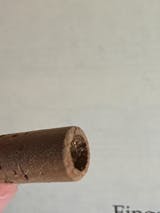About
Bassoons are the bass instruments of the woodwind section in orchestras, often providing the foundation of the harmony in pieces. However, this is certainly not all the bassoon does! Due to the bassoons very large range, over 3.5 octaves, it also encounters singing melodic lines.
The bassoon is often thought of as one of the more comical instruments of the orchestra due to its wide range of expressive capabilities (see the audio examples below). The precursor to the bassoon is thought to be the dulcian (see a picture of a dulcian) which was used from the early 1500's. The jointed bassoon came into use in the1700's and has been continually developed into today's 'modern' bassoon.
- Largest (~8 feet long) and lowest member of the standard woodwind family
- Uses a double reed (two pieces of cane attached to each other)
- It has a conical bore (the hole in the middle of the bassoon gradually gets bigger and bigger as you move to the one end)
Listen
Here are a few examples where you can hear the bassoon!
|
Bassoon & Contrabassoon solo from Fantasia's movie the Sorcerer's Apprentice |
The Reed Rage Bassoon Quartet playing Bassoonist's Holiday...! |
|
Sergio Azzolini playing his baroque bassoon in one of Vivaldi's concertos for bassoon |
Jolivet's bassoon played by Robert Rønnes, an amazing concerto that shows off the bassoon! |
Bassoon Reeds
A bassoon uses a double reed which means that there are two pieces of cane that are attached together. These pieces of cane vibrate when air is blown through the lips which produces the noise to play the bassoon. If you are just starting or are relatively new to the bassoon we recommend that you initially use student bassoon reeds which are free blowing, easy and cheap. A beginner bassoonist requires a free blowing reed to help with the formation of their embouchure. Beginner bassoonists may through accident break their reeds and so the cheapness of these reeds makes the cost more reasonable. We recommend always having three bassoon reeds at all times so that one breaks you always have another to play.
When you become a more advanced bassoonist you will have developed a good embouchure and will be very unlikely to break reeds. This means that you can move onto slightly more expensive bassoon reeds that will produce a rounder warmer sound.
How do I Assemble a bassoon?
View our printable guide about assembling bassoons here! (coming soon!)
Bassoon Accessories You'll Need
 |
Reed CaseA reed case helps ensure that your bassoon reeds last as long as possible which saves you money in the long run! The reed case chosen should allow air to circulate freely so that the reeds can dry fully when put in the case. We suggest that a beginner has a case which holds 4 - 6 bassoon reeds. This means that if one gets broken you have a 2 - 3 more ready to play so you never end up without a reed! |
 |
Swabs / Cleaning ClothsThere are two types of bassoon swabs; bassoon mops and drop swabs. Bassoon mops are fluffy and have to be pushed into the joints of the instrument. These tend to not clean out the curved parts of the joints fully and can leave bits of fluff in the instrument so we do not advise using bassoon mops. We would instead recommend using bassoon drop swabs which are a piece of microfibre fabric with a weight on one end to 'drop' down the bassoon joint and another piece of string on the other end to help remove the swab if it gets stuck. This type of swab cleans every area inside the bassoon with no possibility of leaving fluff behind. |
 |
Seat Strap / SlingWhen playing you need some form of support for the instrument as it is too heavy to hold in your hands alone. This leaves you with lots of options including, neck straps, shoulder straps, body harnesses & seat straps. At Crook and Staple, we suggest that you consider either a neck strap or seat strap. When you are a bassoonist you are usually sitting down and so the support system you usually use should best suit this position. |
 |
Hand RestHand rests / 'birds' will come with your instrument. Each make of instrument has a different variation on the design of hand rest but the main aim of the hand rest is for it to provide support and grip to your right hand. If you lose your hand rest you can pop us an email and we'll try to find the best solution for your bassoon, however, I would advise against losing it as they are not cheap! (I know this from personal experience) |
 |
Water PotSoaking reeds for 30 seconds before playing your bassoon means that the reed will be nearly ready to play well once it is taken out the pot and will help the reed to last as long as possible. Here you can find water pots that magnetically attach to your music stand to avoid water spillages. |
 |
Cork GreaseWhen parts of your instrument become stiff/hard to remove you need to apply cork grease to the cork (don't put too much though as you don't want the instrument to slide apart!) |
|
|
PencilA pencil is vital to write down points in your lesson or to mark items into your music during an orchestral / band rehearsal. There should always be one in your case! We sell perfectly sized pencils with rubbers that easily fit in oboe cases here: Small Music Pencil with Rubber |
Instruments - Rental & Buying
Rental
If you wish to rent an instrument the first port of call is to talk to your local music service or 'music hub'. This is often the cheapest way to obtain a bassoon. For other bassoon rental sources please pop us an email to sales@crookandstaple.com and we will email the sources from which you can obtain one.
New Bassoons
Buying an instrument for a beginner bassoonist is initially an unwise choice as the student may in the future may not want to continue to with the bassoon. We advise you get to about grade 4 standard before considering buying a bassoon. It is often wise to consult your teacher when choosing a bassoon as they will have valuable advice they can offer.
2nd Hand Bassoons
New bassoons are quite expensive so buying a 2nd hand bassoon can be a cheaper alternative. You have to be careful when purchasing 2nd hand bassoons, always take the instrument to your teacher or another very experienced bassoonist to have the instrument checked over.
Bassoon Teachers
At Crook and Staple, we hold a list of bassoon teachers from all over the UK. If you would like details of teachers in your area please pop us an email with what area you live to sales@crookandstaple.com
Starter Bassoon Books
Here is an example of a book you could use:
Tutor BookAbracadabra Bassoon by Jane Sebba begins at the basics and progressively build on previously learnt technique. Interspersed throughout are short pieces and fun duets to play with your teacher. We always recommend you have a bassoon teacher to use the tutor book with as the book cannot demonstrate techniques or provide lessons built specifically for the individual players' needs. |
Bassoon Maintenance
If is important to keep your bassoon in good working order. To find out more click here to view daily, fortnightly and less regular maintenance routines.
Bassoon Accessories for When You're More Advanced
 |
MetronomeThis is not vital for the beginner bassoonist however for the intermediate bassoonist it is essential. Practising with a metronome can be tedious but it pays off, it helps to build up your sense of rhythm and increases the accuracy of your fingers. We recommend that you practice scales with a metronome. |
 |
TunerWhen you are more advanced a tuner will be useful for your long note practice (which is very important for building stamina and tone quality) as it allows you to ensure your tuning is correct at different dynamics/air pressures. The use of a tuner will build any instrumentalists sense of pitch which is vital when playing. |
 |
Reed Adjusting ToolsAs you become more advanced you are likely to gain an interest in how bassoon reeds are made. The first step is to learn how to make adjustments to your bassoon reeds. For more information about this and the tools, you need have a look at our guide on how to make adjustments to bassoon reeds. |
 |
Bassoon StandA bassoon stand it useful for the intermediate bassoonist. When playing in a concert you may have a lot of rests and it is often beneficial to put the bassoon down for a few minutes. Another reason to get a bassoon stand is that it will encourage younger bassoonists to practice more often as they won't have to put the instrument away between playings, although I would suggest cleaning the instrument with a swab to remove the moisture from the instrument. |
This Article Was Written / Collated By
|
|
Bassoonist at Crook and Staple |



